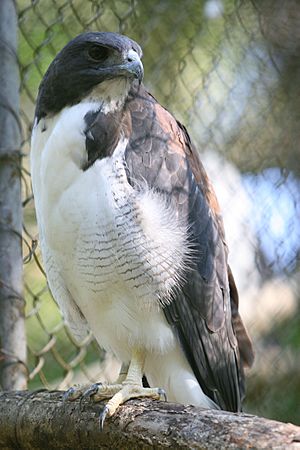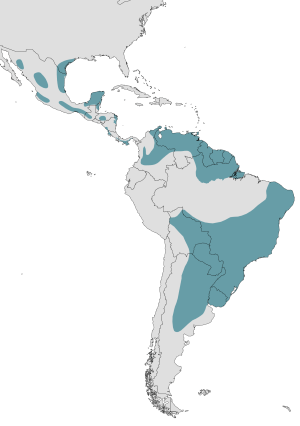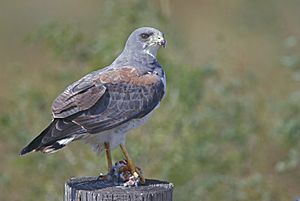White-tailed hawk facts for kids
The white-tailed hawk (Geranoaetus albicaudatus) is a big bird of prey. You can find this hawk in warm, sunny places across North and South America. It lives in both tropical and subtropical areas.
Quick facts for kids White-tailed hawk |
|
|---|---|
 |
|
| Adult at Salvador Zoo, Ondina, Salvador, Bahia, Brazil | |
| Conservation status | |
| Scientific classification | |
| Genus: |
Geranoaetus
|
| Species: |
albicaudatus
|
| Subspecies | |
|
|
 |
|
| Synonyms | |
|
Buteo albicaudatus |
|
Contents
What White-Tailed Hawks Look Like
The white-tailed hawk is a large, strong hawk. It is similar in size to the Swainson's hawk and red-tailed hawk. These birds are usually between 44–60 cm (17–24 in) long. Their wings can spread out to 118–143 cm (46–56 in) wide. They weigh about 865–1,240 g (1.907–2.734 lb).
Adult hawks are grey on their backs and white on their bellies. Their short tails are white with a thin black band near the end. This band is easy to see when they fly. They also have a reddish-brown patch on their shoulders. You can see this patch when their wings are closed. Their eyes are hazel, and their beaks are black with a light-colored base. Their feet are yellow with black claws.
Young white-tailed hawks look a bit darker than adults. They might even look almost black in dim light. Young birds do not have the rusty shoulder patch. Their tails are brown with dark stripes. As they get older, their tails turn greyish with a hazy dark band. Their bare parts, like their beaks and feet, are colored like the adults.
The call of a white-tailed hawk sounds like a high-pitched "ke ke ke...". Some people think it sounds like a goat or a laughing gull. It is usually easy to tell this hawk apart from other birds.
Different Kinds of White-Tailed Hawks (Subspecies)
There are three different types, or subspecies, of white-tailed hawks. They each live in different areas and have slight differences in their size and color.
- Geranoaetus albicaudatus hypospodius
- Geranoaetus albicaudatus colonus
- This type lives from eastern Colombia to Surinam. It goes south to the mouth of the Amazon River and into the Caribbean.
- This hawk is small and pale. Some of these hawks are dark grey all over, except for their tails. Young dark hawks can be completely black except for their tails.
- Geranoaetus albicaudatus albicaudatus
- This type lives in the southern Amazon rainforest down to central Argentina.
- It is large and dark. Its throat is usually black. The dark version of this hawk looks blackish on top and brownish-black underneath.
Where White-Tailed Hawks Live and How They Live

White-tailed hawks live in many places. Their range goes from coastal Texas all the way to central Argentina. They also live on many southern Caribbean islands. They like open areas or places with few trees. These areas are usually below 2,000 ft (about 600 m) above sea level. They prefer dry places and rarely live in very rainy spots.
These hawks do not usually migrate long distances. However, some groups might move to new areas if food is hard to find. They like to sit on bushes, trees, or telephone poles. They also like to stand on the ground or soar high in the sky.
Even though they might leave areas where their habitat is broken up, they live in a very wide range. The IUCN does not consider them to be a threatened species. This means they are not in danger of disappearing.
Hunting and Food
White-tailed hawks often hunt by hovering in the air. They watch the ground for any signs of prey. If they do not find anything, they glide to a new spot. What they eat depends on where they live. In southern Texas, they mostly eat rabbits. In the Dutch West Indies, they prefer large lizards.
They also eat other animals like cotton rats, snakes, frogs, and arthropods. Arthropods include grasshoppers, cicadas, and beetles. Small birds like passerines or quails are also part of their diet. If there is no other food, they might even catch chickens.
White-tailed hawks are also known to eat carrion, which is dead animals. They will gather with other birds at brushfires. They do this to catch small animals that are trying to escape the flames. In tropical areas, white-tailed hawks are major predators of small monkeys called marmosets.
Reproduction and Life Cycle
White-tailed hawk pairs build their nests from fresh twigs. They often use twigs from thorny plants. Nests are usually 5–15 ft (1.5–5 m) or more above the ground. They prefer to build on top of a tree or yucca plant. They choose a spot that gives them a good view from the nest.
The inside of the nest is soft. They line it with dried grasses and other fine materials. They often put green twigs from mesquite or other plants in the nest. This might help keep parasites away. These hawks often use the same nest site year after year. Because of this, their nests can grow very large, up to three feet (1 m) across.
The eggs are white. They sometimes have light brown or lavender spots. A female hawk usually lays two eggs, but sometimes one or three. When someone comes near the nest, the adult hawks will fly up. They watch the person from above. Other types of hawks might wait longer or even attack.
See also
 In Spanish: Gavilán coliblanco para niños
In Spanish: Gavilán coliblanco para niños



